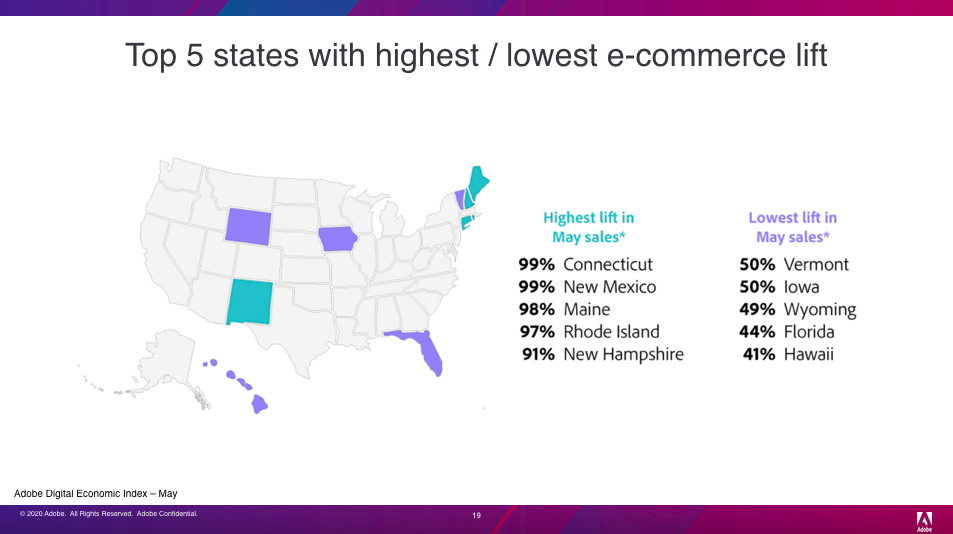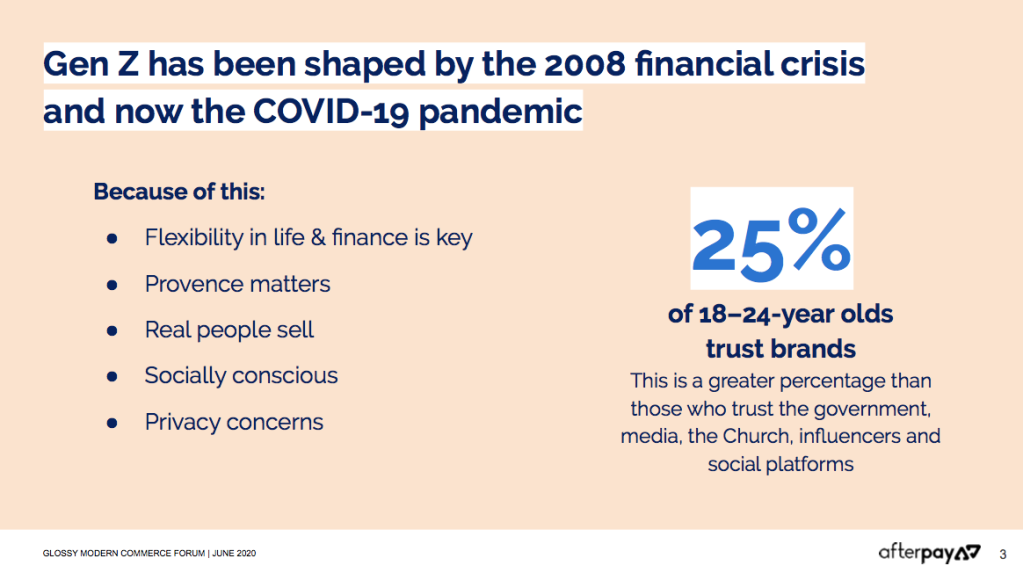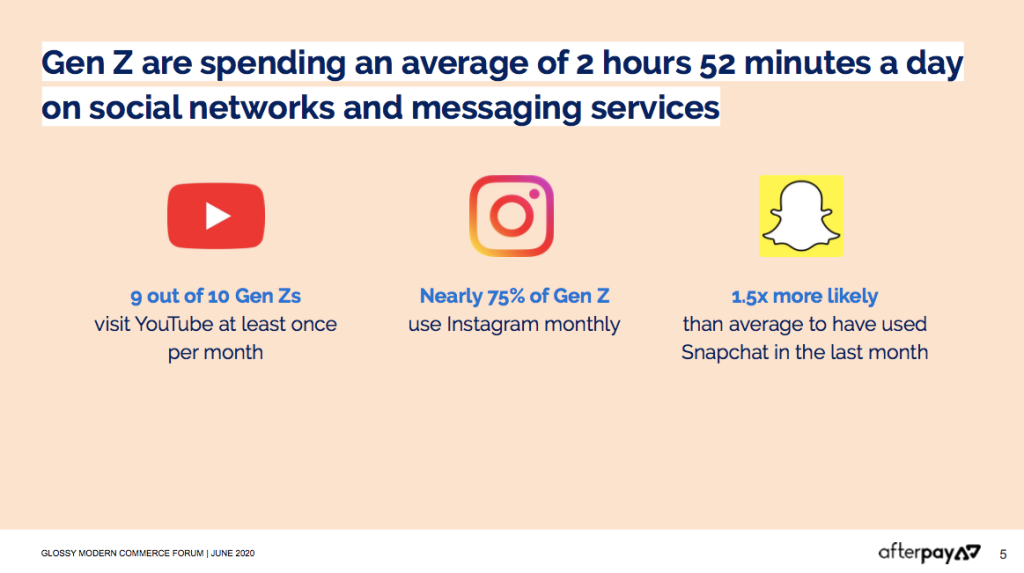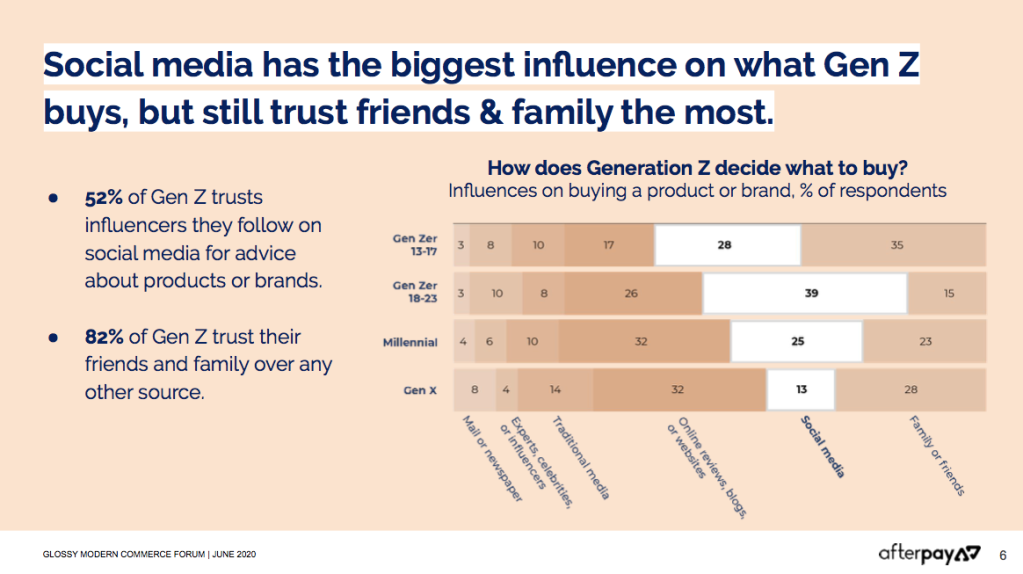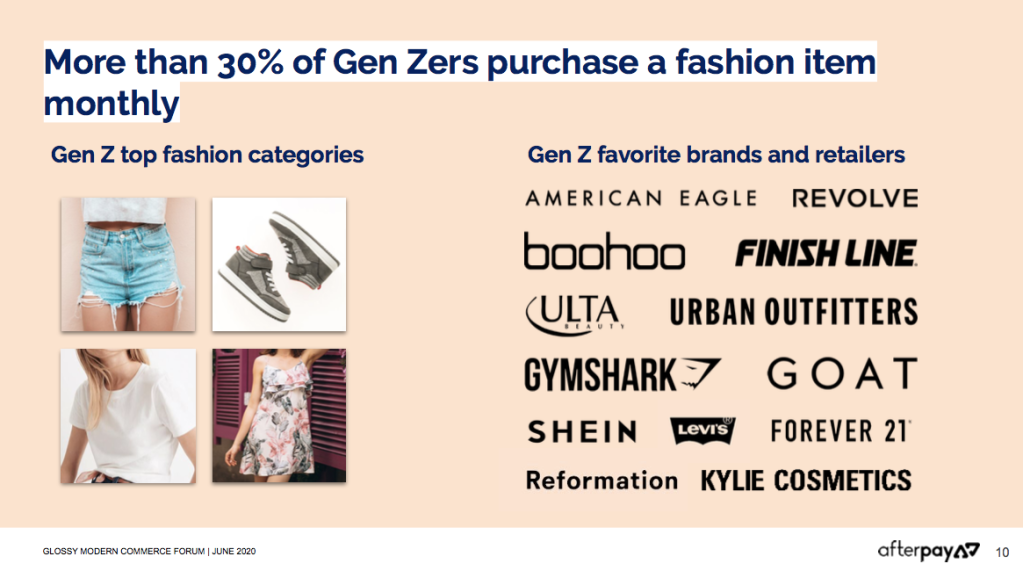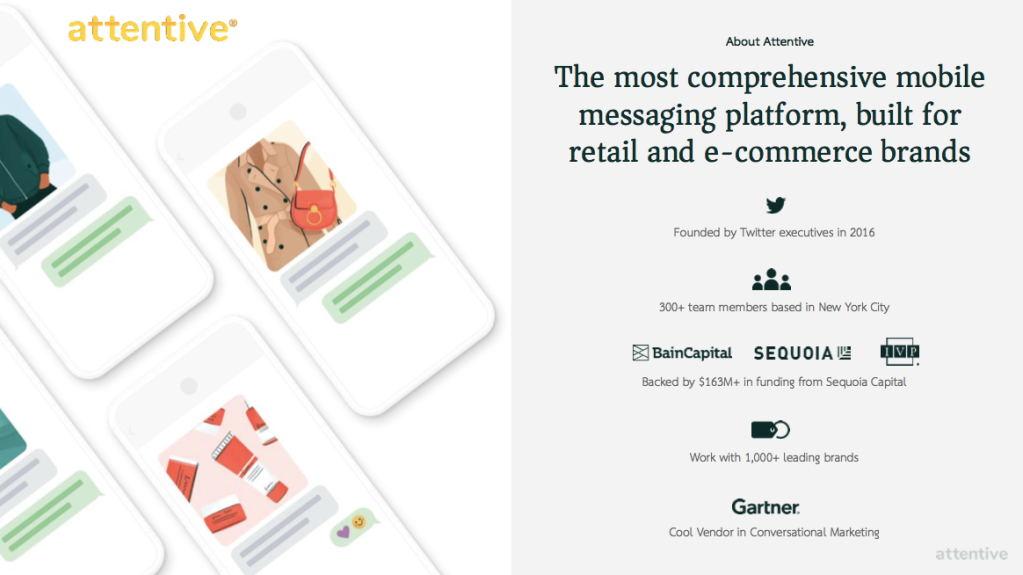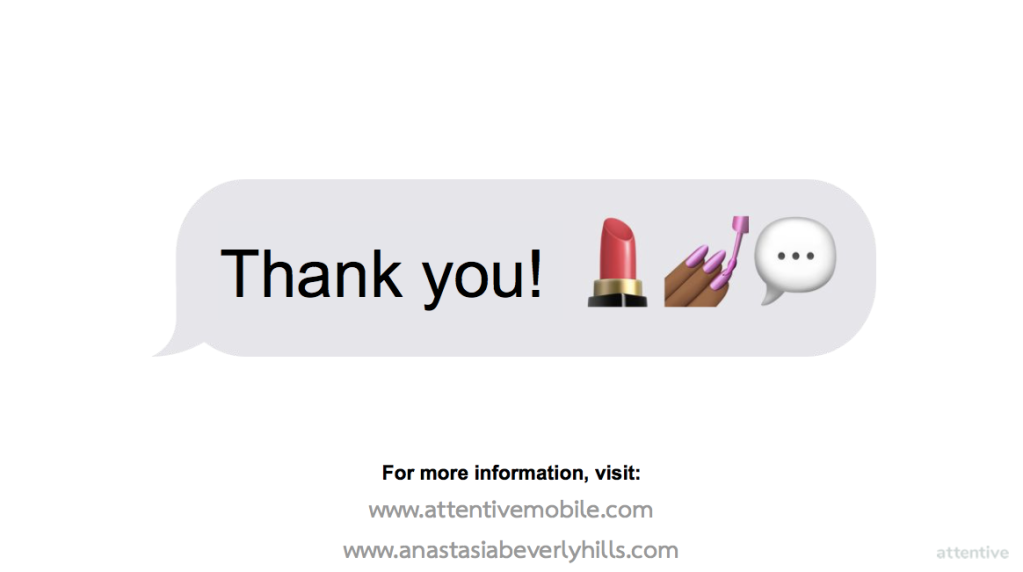In just a few short months, commerce as brands knew it was over. With a pandemic sweeping the globe and a nation inflamed by activism and introspection over police violence, historical injustice and persistent racial inequalities, brands are throwing out their retail playbook. Instead, they are embracing a more community-centric, values-based, digital-first approach to retail, to avoid being left behind. Recent events have accelerated existing trends, from Gen Z behaviors and influencer marketing strategies to omnichannel innovation. It has become critical for brands to work with these changes rather than attempt to ride them out on the assumption that there will be a return to “normal.”
Glossy’s Deep Dive: Modern Commerce is a collection of videos, presenter slides and key takeaways from our recent event that will provide valuable tips and key insights so you’re prepared to succeed in the fast-evolving world of modern commerce. Below you’ll find key takeaways, quotes and stats, as well as videos from our Modern Commerce event, and presenter slides from Afterpay, Attentive and more.
So far, 2020 has been the story of one harsh reality after another, stripping away the idealized veneer that brands present to the world. The Covid-19 pandemic forced brands to rip up plans, cancel flagship events and even pivot operations toward addressing public health concerns and equipment shortages. Then George Floyd was killed, and as America erupted in protest and reflection on racial justice, brands found themselves under the spotlight as never before.
The one constant is uncertainty. Brands can no longer shield themselves from the changes shaking society to its core, nor should they want to. Today’s young consumers see brands as active players in society, not as abstract commercial entities. They expect brands to react to events, and they draw conclusions based on words and actions. A brand that is not part of the solution is likely to be viewed as part of the problem.
We are in a new era. What worked before will not work moving forward, and brands must get out in front of the new reality or risk being swept away by the current. Brands are reacting in multiple ways, but in this deep dive, we’ll highlight a few trends that are defining the path forward.
From now on, values will be the heart of everything a brand does. Some brands have been doing this well for a long time, but others considered values as window dressing. The pandemic and protests over police violence and racial justice have brought values into sharp focus. Consumers are putting their favorite brands under the microscope — what is the makeup of the brand’s DNA, and does it align with their own priorities? Statements are no longer enough, either. Brands need to live their values, and values need to drive everything from product lines to hiring decisions and CSR programs.
“All of a sudden, I think that this reputation we have as a clean company, as a company you can trust, really resonated with the consumer,” said Lilli Gordon, Founder and CEO of First Aid Beauty. “They have fear because of all of the uncertainty and challenges we’re facing right now.”
Lilli Gordon, founder and CEO of First Aid Beauty
The communities brands build around their values are the set to be the bedrock of branding in the new era. Shared values are the starting point, but truly strong communities are a conversation between brand and consumer, and among consumers themselves. What should the brand be? What should it do? Brands are dropping the sales pitch, incorporating feedback at all levels, and learning to invest in communities to deliver valuable resources and even support through turbulent times.
The vernacular and aesthetics of social content are too fractured to sustain the belief that consistency of content across channels is desirable. Brands need to be led by Gen Z consumers first, and that means figuring out a strategy for TikTok — one that doesn’t mean brands themselves getting active on TikTok so much as knowing how to leverage the influence and virality that the platform and its stars command.
With so much business pushed online this year, and many companies struggling for survival, brands are realizing the importance of their digital spaces. Many are confronting the gaps in their digital strategy and charting a course forward, grounded in a reimagining of the interplay between digital experiences and brick-and-mortar business.
Finally, brands are learning that they truly are “all in it together.” Partnerships have never been so important, and the existential threat brands have faced in recent months has been a catalyst for creative thinking around the possibilities of cross-promotions across industry categories.
Here’s what you need to know.
Now is the time to put brand values to the test
Marketers already knew that Gen Z is perhaps the most socially conscious generation on record. However, the events of 2020 have raised the stakes, and it’s now clear that when it comes to speaking out on social questions and political issues, Gen Z and more consumers across generations have higher expectations of brands than ever before.
First the Covid-19 pandemic and, more recently, the protests, activism and calls for racial justice that followed the death of George Floyd have put brands under the spotlight. What is their stance? Are they walking the walk, or are their promises to “do better” just hot air? Some brands have responded decisively, while others have been caught like the proverbial deer in the headlights.
Gordon of First Aid Beauty believes that it’s “1,000% essential” for brands to use their voices assertively, no matter the industry. That begins with listening and paying attention. “I don’t think you can survive unless you listen to what customers want,” Gordon said. Joanna Griffiths, founder and CEO of Knix said that young people can’t rely on political leaders or institutions to speak for them, so instead they’re demanding that brands and founders fill that gap.
- Brands can no longer afford the luxury of planning out social media messages months in advance. Messaging is increasingly interwoven with and responsive to the intensity of the ever-quickening news cycle, and the conversation is changing daily. Gordon said recent events have changed the way she interacts with First Aid Beauty’s social team. “I’ve been speaking to the social team every single day,” she said. “I feel like conversation and discussion is so fluid and so ongoing, whereas before, maybe you’d have a town hall four times a year.” Griffiths said the content calendar has to be evaluated and reassessed — what seemed timely or appropriate a few weeks out might be tone-deaf by the scheduled publishing date. The question to ask, and ask again, is “Is it what people want to hear right now?” Griffiths said.
- Be present, but don’t be performative. It’s a tricky balance to achieve, but brands have to live and breathe their values and company culture, and these have to be tangible to both customers and employees. Platitudes and cliches have never been a good look, but they simply won’t cut it with today’s young consumers.
One of the biggest shifts in mindset has been pivoting from an emphasis on commerce to service, Gordon said. “Our sales have been on fire; we’ve seen crazy growth — more than 3X in our digital channels,” she said. “But we’re not out selling, we’re educating and we’re listening.” Part of that process is figuring out how the current climate should inform research and development of new products, again reflecting that the brand is in-tune with changing values.
Mark Curry, co-founder of The Inkey List said education and sharing knowledge was already part of the brand’s DNA. Brands that have established credibility with their fans as reliable and trustworthy sharers of knowledge were well-placed to speak to current events in a relatable, authoritative way. “We were just about to start a whole campaign on why we thought knowledge is important, which was going to evolve into, ironically, education,” he said. “The brand is built on the flagstone that better information and knowledge drives better everything. You could put that in any single bucket, but in terms of racial injustice, it’s slap-bang center.”
- Mistakes and missteps are inevitable. Those will hurt, but brands need to own their mistakes, take responsibility and move on. Hubris has driven the unmaking of multiple brands and leaders in 2020, from CrossFit’s Greg Glassman to Bon Appetit. A brand’s true fans are likely to reward good faith, integrity and transparency.
Gordon of First Aid Beauty said the answer is to show that you’re constantly and carefully listening. “That goes a very long way,” she said. Transparency also extends to day-to-day operations. The Inkey List co-founder and CEO Colette Laxton said the company built an out-of-stock checker on the website to help keep customers informed in real-time, as the pandemic has thrown up obstacles in supply chains. “We don’t always have the answers, but we want to tell you as much as we know,” she said.
A strong community is a brand’s best defense in a crisis, and anytime
Crafting a community through more communication has never been more important for brands. That’s something many brands have been learning during the pandemic — and for those that have done it well, fostering communities has paid off.
Before the pandemic arrived, designer bag brand Rebecca Minkoff was sending out around four emails a week. In tandem with the introduction of stay-at-home orders, the brand upped the rhythm of its newsletters, sending out six to seven emails every week.
“We got a little scared that we might get some attrition with our customer,” Minkoff said. But the results were striking: The emails were responsible for around 25% of the brand’s sales and were the single biggest driver of handbag sales. “We saw that she doesn’t mind getting emails from us,” Minkoff said. “She’s excited.”
One reason for this is simple: Community matters to customers. People want to belong, and when they find a community worth being part of, they tend to value deeper and more frequent engagement.
Cultivating a strong, well-defined community starts by defining and communicating the values the brand shares with its customers. Gordon of First Aid Beauty said brands should approach this as a critical step in the sales process. “Nobody wants to be sold a face cleanser or a cream anymore,” she said. “They want to be part of the community and in the conversation, and they want to know who you are and what you stand for, and what are your values?”
- Community should inform everything the brand does, from marketing to product development. Consumers want to be a part of the process. Griffiths of Knix said her team has incorporated feedback loops at every touchpoint within its various communities. The brand deploys a variety of methods to gather input from customers, including social media polls and bi-weekly Zoom calls with members of the Facebook-based Knix ambassador community.
The logic is to find out what the brand’s community wants before a product launches, not after, as consumers are going to tell the brand what they think anyway. Griffiths said it’s better to bring them into product development than to receive a series of disappointing reviews post-launch. Knix regularly sources suggestions for products from its community ecosystem and follows through to show those contributions mean something. “You have brands that are paying for focus groups and paying for consumer insights. By taking this approach, we are so fortunate that we actually are inundated with [feedback] every single day,” Griffiths said.
- Strong communities are resilient, and a tight-knit brand community can step up to provide members comfort, support and resources in unexpected ways. Griffiths said that the Knix community was “a wall of strength” during the pandemic. The brand hosted mental health check-ins, allowing customers to talk to customer service reps for 30 minutes and inviting its fans to use emojis to show how they were feeling. And rather than taking unilateral decisions on which organizations to donate PPE to, Knix opened it up to the community. The brand provided a PPE request form that allowed customers to submit requests for masks for organizations in their own communities, and Knix is still shipping mask supplies.
First Aid Beauty employed a similar approach during the pandemic, offering its community a variety of activities including meditation classes, coloring classes and fitness workouts. Initiatives like this add value to the community member, but also give vivid life to the brand’s values.
- Communities communicate with each other. A real community evolves beyond two-dimensional interactions between brand and consumer into a space for multilateral conversations. The members should be talking to each other, reinforcing and amplifying those themes and values that define the community. At Knix, Griffiths said the brand puts an emphasis on storytelling, and that having members of the community telling their stories is just as important as the brand telling stories. In this regard, recognizing and empowering diversity is critical. The brand should lift up community members who represent the brand’s diverse customer base, empowering different people to lead and share.
Meet Gen Zers where they are and let them lead
Gen Z has long preferred the rawness of TikTok’s hashtag challenges and short dance-offs over the hyper-polished, glossy aesthetic of the Instagram influencer — and life under lockdown has further cemented the appeal of authenticity over curation. As TikTok surges in popularity, brands seeking to tap into this powerful market of users, and influencers need to shift their approach.
Tim Bunch, president and CEO of Mav Beauty Brands, said brands’ marketing teams not only need to think about changing the types of content they produce to appeal to the 18-23 year old cohort, but to relinquish control over how these consumers present and interpret their products in a social media setting. Mav Beauty Brands saw its Strictly Curls products selling out at “incredible rates” due to their virality on TikTok.
“Lean into what creators and the users of the platform are doing,” Bunch said. “Do not try to force your brand messaging, do not try to force your brand equities. Really lean into how they’re using the product, give them the product, and let them create. That’s what they do so well.”
Tim Bunch, president and CEO of Mav Beauty Brands
MAV Beauty Brands have adopted a number of new ground rules to succeed on the fast-growing platform:
- When venturing into TikTok territory, brands will need to let go of visual consistency and embrace emotion. “The hope is that when a content creator creates something about your brand, that it feels like what you want your users to feel after using your product,” Bunch said. “If that’s accomplished, I think that’s a bigger win than trying to nail some messaging points that could come across as branded or artificial.”
- TikTok’s videos are ultra short, so brands need to “look at what could add value to people’s lives and can be demonstrated on the platform in less than 6 seconds,” Bunch said.
- Brands may need to rethink their influencer strategy. Instead of hiring paid influencers for endorsements, MAV Beauty Brands found users on TikTok who were already posting about its Strictly Curls line. They reached out to these users to thank them, sometimes offering free products with the goal of achieving more organic reach through further content creation. The Inkey List co-founders Colette Laxton and Mark Curry said the brand’s hashtag garnered 2.4 million views in just over a week. It’s about using “native content to inform what people want and the conversations they want to have,” said Curry. So far, this has come through in an “under $50 skin-care routine” challenge where the brand’s products are featured.
- Content creators don’t always tag brands, which can make it difficult for marketers to know where to start. Bunch suggests finding people that embody the imagery and feel of your brand. “Don’t be so concerned at first if it’s going to be tagged,” he said. “If people like the person and like what they’re wearing, they’re going to go in the comments and ask.”
Collaborations and cross-promotions can be a brand’s best friend
Just as it would be unwise to stick to one digital channel for audience growth, brands are discovering that failing to look beyond their own brand would mean missing out on acquisition opportunities. For Rebecca Minkoff, cross-promotions with like-minded brands in recent months was what drove 70% of new traffic to the brand’s website, which Minkoff called “phenomenal and unexpected.”
Minkoff’s strategy has been working with mainly female-founded companies with audiences that have similar values to her own. “Once we have [these new customers], it takes two to three weeks, and they’re converting,” she said. And with everyone at home and spending more time on social media during the pandemic, these partnership opportunities can come about in unexpected places. Minkoff’s collaboration with clean hair care company Madison Reed kicked off somewhat organically after she was using one of its products in her own social media feed and received an overwhelmingly positive response from her followers.
There are a few things brands considering collaborations should keep in mind:
- Brands should be thinking outside of their own category, not only because they don’t want to cannibalize each other through cross-promotions, but because it creates a unique chance to attract completely new audiences. Sarah Benady, CEO North America at Ba&sh, said this was the case when working with Reebok, where she discovered a huge community of women looking for technical outfits with a fashionable twist.
- Collaborations are a way to come up with an exclusive product or collection for a brand’s own network, but this can be more challenging to pull off without a direct-to-consumer outlet, Benady said. Even if two brands aren’t both juggling communications with one wholesale partner, partnerships can still make it more difficult for one brand to have control over steps including production, timing and distribution.
Sometimes partnerships come about organically, and once they’re underway and successful — Minkoff said her brand collaboration with Madison Reed drew an uptick in both revenue and customer engagement – it’s important to keep the ball rolling. “There was one night we saw a spike in sales, and we couldn’t figure out why, and it was because Madison Reed sent out an email to its database saying, ‘Reminder: last chance to use the promo code [for Rebecca Minkoff],’” Minkoff said. “So when you get that type of synergy, you just keep fueling that fire.”
As physical retail has been demoted, digital innovation must happen
If brands were moving at a steady trot toward digital innovation, the pandemic has pushed them into a full-on gallop. Direct-to-consumer sales are on the rise as department stores struggle to maintain their allure, while experiential retail has taken on a completely new meaning as brands have pivoted to a virtual-first existence. The future of brick-and-mortar remains uncertain, even as cities move toward opening up. Ethically sourced jewelry brand Aurate, for example, has been forced to rethink its store strategy to reflect customer demand, working with landlords to obtain flexibility and pushing back plans for store openings this year.
All of this has underlined the need for brands to get their digital strategy right, and in some cases this means further integrating their online and offline channels. Rebecca Minkoff, for instance, dedicates a section of her store to livestreaming.
In other cases, it’s about being open-minded about online retail partnerships and distribution to optimize product discovery.
“Globally in our company, digital transformation has really come to the forefront, and there was no more perfect timing,” said Jessica Hanson, president and general manager of AmorePacific. “How we fuel our digital teams, how we think about our content, how to get to market quicker — the only way you can do that sometimes is by doing it in a virtual space.”
- Lowering the offline footprint means in-person customer service needs reworked; it’s crucial that brands need to find new ways to communicate and engage. Rebecca Minkoff is achieving this through SMS messaging. “Text is the most intimate form of communication on your phone,” Minkoff said. In-store data collection on customers had been a valuable tool for ethically sourced jewelry brand Aurate, so when that was not possible, founder Bouchra Ezzahraoui’s team shifted to reaching out to customers directly, calling shoppers just to check in on them and ask for feedback.
- Omni-channel retail has taken on new meaning as priorities for retailers shift to digital, prompting brands to leverage their offline space to focus on serving online goals. Rebecca Minkoff believes smaller stores and flexible leases are the way of the future, and currently transforms her own shops to enable livestreaming and entertaining customers with IG Live-style how-tos and interviews with other female entrepreneurs.
- The new normal has pushed brands to rethink “the human touch” in a digital format, and brands may need to continue on this path even after stores reopen. During the pandemic, Aurate kicked off virtual private styling sessions that would normally take place offline. “We just need to be very creative in bridging the gap between physical and virtual experiences,” said Ezzahraoui. “What stops us from having those experiences outside of the store?”
Overheard
“Historically, we looked at brands and we believed that their job was to be aspirational. Then with Covid, we started to shift toward this idea of inspirational brands.”
Joanna Griffiths, founder and CEO of Knix
Brands are moving away from the neutral positions they have traditionally staked out on social issues and are moving toward adopting assertive stances. The old norm was for brands to sell their products and services as part of an idealized, aspirational lifestyle. In the new paradigm, brands accept responsibility for setting an example for employees and customers alike. At Knix, Griffiths said the Covid-19 experience paved the way for this shift. By the time internal discussions came up about Black Lives Matter, the brand was prepared to take a stand — not just with a one-time donation, but also with an agenda for the long haul.
“We asked our team to be 10 out of 10 flexible, 7 out of 10 on delivery.”
Mark Curry, co-founder of The Inkey List
Curry said the experience of dealing with different learning styles in his past life as a teacher clarified the importance of flexibility. He related this to the challenge of capturing consumers’ imaginations across the enormous variety of touchpoints through which they encounter brands. Today, this means everything from TikTok videos to search terms and beyond, and tomorrow will bring yet more new and potential interfaces between brand and consumer. Curry said the challenge for brands is to deliver information and messaging in a variety of ways that allows consumers to have the conversations they want to have with the brand — and it doesn’t work every time.
“You can’t just put a consumer in a box and think that we know exactly what they love, what they don’t like, what they’re willing to do and what they’re not. We have to really pay attention and really listen to what’s happening in order to relate to them.”
Jessica Hanson, president and general manager of AmorePacific
Consumer behavior is hard to predict, and the Covid-19 pandemic was an unprecedented test of how people would respond in a crisis. With no reason to go out, it seemed likely people would stop using skin-care products altogether. Instead, AmorePacific’s Jessica Hanson said that some consumers used the extra time they had to refine their skin-care routines or experiment with new products and approaches. For others, looking after their skin helped maintain a sense of routine or offered an escape from the stress of the pandemic. In the end, these consumers actually used more skin-care products than they normally would. This somewhat surprising variation of reaction underlines the need for brands to be in-tune with what their customers are feeling in the moment so that they don’t miss an opportunity to deliver.
Glossy 101
What is Elite TikTok?
Sooner or later, teenagers will find a way of sorting themselves into in-groups and out-groups. It’s the story of every high school movie and teen soa, and now it’s happened on TikTok. The ByteDance-owned app has become famous for its viral dances, challenges and musical memes, but some TikTok users have decided this routine is tired and are exploring a new, stranger aesthetic. This is Elite TikTok. The “elite” designation stakes a claim for the superiority of the new approach to TikTok. Elite TikTokers deride their dance-happy counterparts as “straight” TikTok.
Elite TikTok videos often take aim at straight TikTok, mocking the genre for its earnestness, parodying its tropes, and projecting storylines onto the lives and personas of its stars. Elite TikTok users have created a tongue-in-cheek campaign for the liberation of a member of TikTok family band SM6, under the hashtag #FreeAdam2020. One subset of Elite TikTok is Retail TikTok, a trend that sees teens creating accounts where they play-act in the imagined persona of a brand, right down to giving those brands a voice and an emoji-powered “face.”
What is Retail TikTok?
If a brand truly had a personality — as in opinions, values, and an expressive voice and face — what would it be? That’s the question Retail TikTok answers, sometimes with hilarious results. “Elite” TikTok users started playing around with creating these brand caricatures in late 2019, but it was April 2020 before the faux @PurellOfficial account featuring videos of an animated bottle of hand sanitizer became Retail TikTok’s breakout star.
The genre has expanded to include hundreds of representations of brands, some in tribute, others mercilessly parodic. Some users use emojis and filters to superimpose the brand’s “face” onto a storefront or even the branding itself.
Many of the people behind these accounts are teenagers, and the content can be a telling — if often bewildering — expression of the younger generation’s attitude towards brands, capitalism and consumerism. Some brands are lampooned and “canceled,” while others receive more sympathetic and earnest treatments. In some cases, the creators project familiar adolescent storylines onto the brand personas: In Retail TikTok, brands fall in love, and form friendships and bitter rivalries.
The Burlington Coat Factory TikTok parody is one of the most popular examples of the genre. It features a heavily distorted voice, backed by sound effects that are reminiscent of a nightmarish soundscape from an experimental open mic night.
Tim Bunch of MAV Beauty Brands said brands should be paying attention to what’s happening in Retail and Elite TikTok, and when they leverage TikTok, they should, in general, “lean into the weird.”
“What they do may not totally fit what I think of as the brand,” he said. “But they’re users and it’s what they think of the brand, [so] it’s OK.”




















